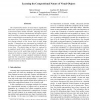Free Online Productivity Tools
i2Speak
i2Symbol
i2OCR
iTex2Img
iWeb2Print
iWeb2Shot
i2Type
iPdf2Split
iPdf2Merge
i2Bopomofo
i2Arabic
i2Style
i2Image
i2PDF
iLatex2Rtf
Sci2ools
109
click to vote
CVPR
2007
IEEE
2007
IEEE
Learning the Compositional Nature of Visual Objects
The compositional nature of visual objects significantly limits their representation complexity and renders learning of structured object models tractable. Adopting this modeling strategy we both (i) automatically decompose objects into a hierarchy of relevant compositions and we (ii) learn such a compositional representation for each category without supervision. The compositional structure supports feature sharing already on the lowest level of small image patches. Compositions are represented as probability distributions over their constituent parts and the relations between them. The global shape of objects is captured by a graphical model which combines all compositions. Inference based on the underlying statistical model is then employed to obtain a category level object recognition system. Experiments on large standard benchmark datasets underline the competitive recognition performance of this approach and they provide insights into the learned compositional structure of objec...
Category Level Object | Compositional Nature | Compositional Representation | Compositional Structure | Computer Vision | CVPR 2007 | Structured Object Models |
Related Content
| Added | 12 Oct 2009 |
| Updated | 12 Oct 2009 |
| Type | Conference |
| Year | 2007 |
| Where | CVPR |
| Authors | Björn Ommer, Joachim M. Buhmann |
Comments (0)

